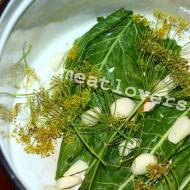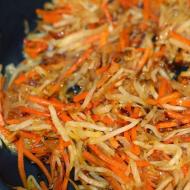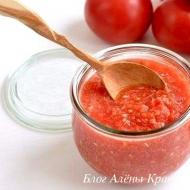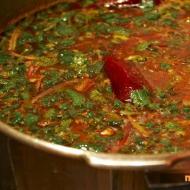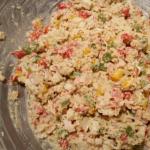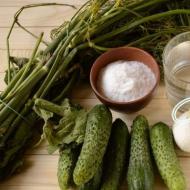
Salt in a barrel. Barrel cucumbers without barrels
Barrel cucumbers, either pickled or salted, who as they call them - this is a very tasty preparation. Well, what about it? After all, these cucumbers are not only appetizing on their own due to their hearty taste, but they are added to vinaigrette, pickle, and Russian salad. Now you can buy such cucumbers everywhere - in stores and on the market. But why buy such cucumbers, if you can prepare them yourself.
The essence of the recipe is that cucumbers begin to ferment and release lactic acid, which will become a preservative. To start the fermentation process you need a lot of salt. So do not be surprised that there is a lot of it in the recipe. For the recipe, use the usual rock salt itself without additives, iodizing, use of extra salt is also not recommended.

How to cook salted barrel cucumbers for the winter in banks
First you need to wash the cucumbers well and soak them in cold water for several hours. This is the success of tasty and crispy cucumbers. While cucumbers are soaked, prepare jars - wash them thoroughly and pour boiling water over them. It'll be enough.
In each jar at the bottom put a sheet of horseradish, a leaf of cherries, 1 umbrella of dill (if you can have two small ones), a few cloves of garlic (put the rest on top), do not forget about black and allspice.

Now we put cucumbers in the jar. It is very convenient to put them in a jar tightly to each other. Small cucumbers leave in order to lay them on top. There is a small distance between cucumbers, you can put garlic in it.

Pour salt into the jar.

Fill the banks with clean water. Clear water is bottled or from a filter, but not boiled. Pour cold water.

Top cover cucumbers with a leaf of cherry, horseradish or currant. So cucumbers will not come into contact with oxygen.
All specified leaves must be washed, take only fresh, not yellowed leaves.
Cover the cans with nylon covers and place in a warm place for 3 days. Nylon cover is better to take with holes, because in the sourdough process, the pickle is likely to come out of the jar.
You can still cover the banks with gauze. And to the brine was where to go, put each jar on a plate or tray.
The next day you will see cucumbers begin to change their color to darker.
On the second day, a frothy hat will appear, and the brine will begin to cloud, which means that the fermentation is proceeding as it should. We leave cucumbers for one more day, on this day the salted pickle may partly pour out of the jar.

Now pour the brine into a separate pan. And bring it to a boil. Cucumbers in the meantime, you can rinse - typing several times in a jar of clean water and drain it. You will wash away the white bloom on cucumbers, i.e. remove the lactic acid product and fermentation will be stopped. If you plan to eat cucumbers immediately, put them in the fridge and reach for them as needed.

Fill cucumbers with boiling brine and immediately roll the jars with lids. You can try cucumbers in 2 weeks. Before that, they will be lightly salted, and after the specified time, they will taste like cask.

Wrap cucumbers to cool. And transferred to storage in the basement or closet, insisting, jars of pickles again become cloudy, this does not need to be afraid.

We got a great snack for vodka, collect pickles in jars, because in apartment conditions it is difficult to preserve in a barrel. Such preparation will last all winter, and your husband will be grateful to you for the taste of delicious barrel-shaped cucumbers. Good blanks you.
I have never met a man who would be indifferent to all kinds of homemade pickles. And I'm not talking about the process of sterilization and canning, but about a plate of pickled or salted snacks. Here you can only argue - someone left is more like it, but someone has more sugar.
But pickled cucumbers (not salted and not pickled!) Stand out in a certain way, they are also called cask. It is here that all lovers of winter snacks from a can are broken up into two camps - some like such cucumbers until they tremble at their knees, and others like them, they stink, and in general, fu!
I am among the first! Crispy, hearty, filled with juice, only such a cucumber is tasty for a glass of vodka, and only such a cucumber is worthy of a vinaigrette.
While I was a city girl and I had only a refrigerator, I often visited the market in a tent from the local farm - there, besides sweet onions and juicy carrots, sauerkraut and the very real barrel cucumbers were always sold. I immediately bought 10 pieces and a half in the car I ate, smearing everything around with brine)))
And when we got a cellar, I wondered - is it possible to cook the same delicious cucumbers at home?
Of course, at first I tried to get an oak barrel for pickling, but then I realized - I started from the wrong side! First of all, need a recipe! And I got it! All the details of cooking barrel cucumbers were told to me by an aunt in the market from which I always bought these cucumbers. True, she revealed this secret to me, she lost me as a buyer - after all, now both barrel cucumbers and sauerkraut I can do myself)))
Although, I wrote down the recipe with doubt, but “It couldn’t be that simple!” Was spinning in my head. Well, I really didn’t believe that in order to get such tasty food on a plate, cucumbers must first turn sour (roughly speaking, spoil!) and then magically turn into a delicacy!
Indeed, the recipe is so primitive that if cucumbers have already been selected, consider that half the work has been done!
What pick cucumbers? Of course, delicious, strong, flawless, straight from the garden.
It is believed that pickled cucumbers with thick peel and black thorns are best suited for pickling and pickling - special pickling varieties (the breeders even bred the common “Masha” variety). Such cucumbers are well kept (last year a couple of buckets quietly reached the cellar until March), they remain crisp and strong.
But gentle, with velvety fluff - they are better in salads. In salting they are stored poorly, and if such cucumbers sour, then pretty quickly they turn into muddy soap. Although, if you do not plan to store the billet until spring, you can try this recipe with any cucumbers.
And the size? Yes, when you make barrel cucumbers, size does matter! It is verified that the larger the cucumber, the more harmoniously the magical processes within it take place. Of course, one should understand that the cucumber did not outgrow to the size of a zucchini, was covered with a thick skin, turned yellow from one side, and inside there were huge seeds, there are simply large-fruited varieties - cucumber can be at least 30 centimeters long, but remain juicy, tender and not overripe.
One bad luck with such long cucumbers - what is their sour? Here, the usual three-liter jar, and a cucumber sticking out of the neck ... And how many such copies with a jar will fit - three, four?
Therefore, my choice - plastic bucket containers. They come in different sizes (from half a liter to 12!), With airtight lids, walls are transparent enough to spy on what is happening inside (it is easy to control the turbidity of the brine and its level), but most importantly, the diameter of the bottom and the neck do not differ much.
This container is four-liter. And here is the cucumber that was sticking out of a three-liter jar - yes, you can at least ten of these cucumbers put in a pile!
But no matter what sort of cucumbers you chose for pickling - all of them must be washed and soaked in cool clean water for at least 2 hours, and preferably at night. Cucumbers absorb water and less “drink” brine.
For now let's do some delicious accents! We will gather fragrant herbs on the beds - dill (delicate twigs and tough stems, flowers and ripened umbrellas), garlic (and heads, and green feathers), horseradish leaves, parsley (entirely with roots or only leaves), cilantro (leaves, flowers, green seeds), sprigs of mint, basil, thyme. Do not forget about the leaves of black currant.
If there are no beds, and the grandmother is far away in the village, there is a direct road to the market, fragrant “brooms” with everything necessary are sold there.
Also in the cucumbers is excellent bay leaf, hot peppers and peppercorns.
Another good thing to add cherry leaves. In our region, such a cherry is called a sweet cherry or “cherry on a leg,” its leaves are small, but there is plenty of flavor.
I came with friends to the country with gardening scissors and brought a real cherry bouquet - chop the leaves into blanks, chop the twigs into hot smoked chips, eat berries!
By the way, if you didn’t use all the leaves at once, put them in a bag and keep them in the refrigerator - they are lying for several weeks; You can also save the "extra" leaves of black currant and horseradish.
But real cask cucumbers are therefore cask-based - they are barrels with taste, ideally oak. We will “cheat” - we will add dry oak leaves in the bucket. Of course, they are not as fragrant as fresh ones, but what to do if real oaks do not grow here? After all, are we in the kitchen using dry bay leaves?
There are almost no problems with dry oak leaves - you need to buy an oak broom. Just do not buy it in a beautiful package in a supermarket (suddenly it is processed or old), look around the city baths - there they always sell brooms made from birch, fir, juniper, and from oak, sometimes, they are found. I know, one uncle specially brought oak brooms from the Far East.
Such a broom will suffice to pickle a few buckets of cucumbers and in the bathhouse it will remain))
Well, about the salt I will say more! Take a big pickling and not iodized! With iodized billet is not worth it and quickly sour.
As you can see, there are more words and theory, let's do business!
Plastic sealed buckets (or glass jars, if you suddenly make them) wash with soda, do not need to be sterilized. The more correct bacteria remain, the better the fermentation process will go.
At the bottom we put a mixture of herbs, a few peas of pepper, a sheet of crap, half filled with cucumbers, laying them as closely as possible. Again a layer of herbs, again, cucumbers and on top still green. We cover with a sheet of horseradish, without fanaticism, ram the contents.
Salt is sprinkled on top - 1 tablespoon per liter of container (4 liters of my buckets mean 4 tablespoons), and fill it with UNKNOWED filtered water, can be from a bottle, it can be mineral water, it can be spring water, only without chlorine. We leave for half an hour and if we need to top up some water.
We leave the buckets (jars) at room temperature, prudently they need to be put in a bowl, on a large plate or baking sheet - they can flow. We loosely cover with lids or a saucer (from dust and insects), shake a couple of times in the evening so that the salt is distributed more quickly throughout the brine volume.
The next day, foam will appear on the surface, someone will say “oh, oh, turn sour!”, And in fact the process has been launched!
And in a day or two the brine will grow cloudy - tightly close the lids and put them in the basement or in the fridge, if they made a small batch. Now cucumbers should stand at a temperature not higher than 8-10 degrees during the month. They cannot be stored at room temperature!
Over time, the brine will brighten a bit, but it will still remain cloudy, and bright green cucumbers will turn brown.
As I have already said, such cucumbers stand until spring, do not turn sour, do not grow moldy, only the taste becomes ever more vigorous. The hare even joked that he would carry a fork and a stack, drink and eat because there is a cellar, and to go around the house to drown - just along the way)))
Have a nice Have a snack!
A barrel in our time is a rarity, and not everyone has a basement, but real barreled cucumbers with a familiar taste since childhood, I really want to.
Salting of cucumbers in a canning system invented by housewives is very simple, and some of the proposed recipes do not even require boiling water and rolling under the lids.
Cucumbers are obtained as barrel, and they can be used for vinaigrettes, pickles, for a snack.
And they are good because they are prepared without vinegar, citric acid or aspirin.
As a result of fermentation, acid is released, which acts as a natural preservative.
Medium and large dense cucumbers are best suited for such blanks.
There are also special varieties for pickling, but the most important thing is that the vegetables are fresh, preferably only from the garden.
If it seems to you that the cucumbers are peroxide or too salty, then pour them with tomato juice and put them in a refrigerator for a couple of days.
A pleasant sweetness will be felt in the billet, and the juice will take away excess acid and salt, acquiring a special flavor.
Harvesting pickled cucumbers as a barrel for 3 liter jar
Ingredients:
- cucumbers - 2 kg
- salt - 3 tbsp. spoons with a small hill
- garlic - 3-5 cloves
- horseradish leaves
- dill umbrellas
- black or allspice (peas)
How to make barrel cucumbers in a can under a capron lid:
1. Wash cucumbers and cut the tips.
2. In a clean 3-liter jars, put garlic and peppercorns.
3. Put cucumbers in jars.
4. On top, place the leaves of horseradish and dill so that they cover them and do not allow to emerge.
5. Pour salt and pour cold water from the tap, better, of course, filtered, to the very top.
6. Tightly close the jars with well-fitting kapron or thermal covers.
7. Transfer banks to a cold place.
Cucumbers cooked according to this recipe are stored for a long time, sometimes up to two years, but can be sour over long-term storage.

Pickled barrel cucumbers 10 liter jar
Ingredients:
- 5.5-6 kg cucumbers
- 4.5 liters of water
- 7 tsp full of salt
- dill, celery
- horseradish sheet
- garlic
- hot red pepper - 3 pcs.
- dry mustard - 2 tablespoons
How to make cucumbers in a 10 liter bottle:
1. Stir the salt in cold water and let stand.
2. Wash cucumbers, do not cut the tips.
3. Slice greens and divide into 3 parts.
4. Place the cucumbers in the bottle, shifting them with herbs, garlic and peppers.
5. Pour cucumbers with pickle.
6. Cover with a piece of horseradish and sprinkle mustard on top.
7. Close the nylon cover, let stand warm for 2-3 days, then transfer to the basement.
Cucumbers are obtained as barrel, spicy and crispy.

Pickled cucumbers in jars as barrel with mustard
With the addition of mustard, the cucumbers will turn out especially crunchy.
And the crunchy properties of cucumbers can be given by adding amaranth or shchiritsy leaves to the jars.
Ingredients:
- 1.5 kg of cucumbers
- 1 tablespoon dry ground mustard
- 65 grams of salt
- 3 leaves of cherry, raspberry and currant
- 6 grains of allspice and black pepper
- 5 umbrellas of dill
- 2 sheets of horseradish
- 5 cloves of garlic
- 3 l of ice water
- rock salt
Recipe for cucumbers in a barrel with mustard:
1. Put drinking water in the freezer for 1 hour, it will be needed for soaking and for brine. Fill it with washed cucumbers for 1.5 hours.
2. At the bottom of a clean two-liter jar, place all the spices and leaves.
3. Then firmly tamp cucumbers.
4. Fill with ice water.
5. Drain the water from the can, measuring its volume, approximately it will be a liter.
6. Dissolve salt in it and cover cucumbers with ice pickle.
7. Pour the mustard.
8. Close the capron cover and leave to warm for 3 days.
Put the jar in a deep dish, because the pickle will flow out.
9. When the pickle becomes cloudy, and the cucumbers change their color, you can put them in the basement or the fridge.
Recipe for barrel cucumbers in cans under an iron lid
The method of preparation of pickled cucumbers, as in a barrel, consists of 2 stages - vegetables are first fermented and then rolled.
The obtained barrel cucumbers can be stored in a glass jar even at room temperature, if you do not have a basement.
Ingredients for 3 liters:
- cucumbers - 2 kg
- garlic - 4-5 cloves
- horseradish sheet
- dill umbrellas
- currant leaves
- peppercorns
- salt - 100 g
- water - 1.5 liters
How to squeeze barrel cucumbers with seaming:
1. Soak cucumbers for 2 hours in cool water, wash and cut the ass.
2. Place the leaves and garlic on the bottom of 3-liter cans (or simply in a bucket), and on them - cucumbers.

3. Dissolve the salt in 1.5 liters of water and pour it into the jar so that the water covers the cucumbers.
At the neckline, lay dill stalks so that cucumbers do not float.
4. Cover, without closing, capron lids and leave to ferment at room temperature for 2-3 days.
5. Pour the brine into the pan, making sure that no garlic or pepper gets into it.
6. Put on the stove and bring to a boil, removing the resulting foam. At this time, wash the cucumbers and transfer them to clean jars.
7. Pour the boiling brine over the cans and leave for 1.5-2 hours, covered with a lid, and above - with a towel, drain again and boil.
8. Fill and roll with metal lids.

Cooking barrel cucumbers with sugar
Ingredients:
- per liter of water - 2 tbsp. spoons of salt and 1 tbsp. spoon of sugar
- tap water
- cucumbers
- dill
- garlic
On the three-liter jar will need about 1.5 liters of brine.
How to close canned cucumbers as a barrel:
1. Dissolve salt and sugar in water.
2. Put spices and cucumbers in clean jars, cover with brine.
3. Cover the jars with gauze and leave at room temperature for 3 days, regularly removing the foam that appears.
4. Drain the brine in a saucepan, boil it. Throw the leaves, leave the garlic.
5. Pour into sterilized jars with washed cucumbers and spin with iron lids.
Recipe for barrel cucumbers with video:
Blackberries thanks to the work of breeders, obtaining varieties completely devoid of thorns, as well as travelers and tourists who brought new foreign varieties with high quality fruits to our continent, are gaining increasing popularity and more and more often can be found in garden plots. Blackberries, as a rule, only when grown on a trellis, which must be installed in the second year after its landing on the site.
Strawberry, or garden strawberry, as it should be more properly called, is the most common berry crop. It competes only with honeysuckle, but not by area, but by the time of the appearance of the first berries. It is these two cultures that are the first to enrich us with vitamins, sometimes the most important. In our article we will try to tell you about whether it is necessary to shelter our favorite berries for the winter from the severe frost and, if necessary, how to do it correctly.
Today you can not go for bread, because you and I will bake delicious focaccia - lush, flavorful Italian bread! With all the variety of recipes, focaccia is easily recognizable by its features: its surfaces have nice “dimples” that are formed when the cake is formed when you press the dough with your fingers. It is interesting to know that these dimples are needed not only for beauty - oil is collected in them, protecting the crust from drying out, and the bread is soft.
Among the indoor plants are not so many ferns, and their popular types can be counted on the fingers of one hand. But few ferns have such impressive beauty as one of the rarest species - phanoflebic or tintomyum. This fern is so rare that it is considered the least suitable for room culture. Such a reputation is all the more unfair because elegant cirtomeum is undemanding of temperatures, lighting and even care.
Pumpkin pie on kefir with dried fruits is one of the simplest, inexpensive, but, nevertheless, beautiful pies, which is not a shame to serve not only for evening tea, but also on the festive table. Golden yellow inside, moderately sweet, slightly moist, with pieces of dried fruit and sour cream, it is eaten to crumb, as soon as it appears on the table. Any dried fruits and candied fruits - figs, dried apricots, dates - are suitable for the filling, and at the same time clean your kitchen warehouse.
So, the summer season, one might say, is already behind, and it becomes somehow sad. The summer quickly flew by, there was a lot of work and worries. In the garden, in the garden, on a flower bed, the overwhelming majority of the works have already been completed, the garden is empty. The harvest is also mostly cleaned, packed and safely hidden. But one should not let the waves of pessimism on oneself, because if one tries and applies a little knowledge, then one can extend the autumn and return the summer home by building it on the windowsill.
The problem of running, overgrown, weed-hit areas sooner or later confronts any gardener. The task of clearing is not only related to the situation when you acquire a suburban area in a deplorable state. Old flower beds or “forgotten” lawns, overgrown arrays or uncontrolled weeds that weren't started to fight in time is not a rare situation. And the main key to success in solving the problem - patience and endurance.
Pork fajitos is a recipe for a spicy Mexican snack, which consists of beef stew with vegetables, chili and fresh salad. According to tradition, all ingredients are wrapped in a round flat cake made from unleavened dough made from wheat or corn flour - tortilla. In Mexico, Fahita is served to the table separately - meat, vegetables and tortillas, and you yourself collect your version of the dish. Collect fajitos need immediately before serving, so that the cake is not soaked.
Winter is the most crucial period for apple trees and you need to survive it with minimal losses. In general, the complex of activities includes late harvesting, collecting and destroying fallen leaves, digging the stalk strip, dressing, water recharge irrigation, mulching the stalk zone, removing lichens and moss from trunks, stripping the bark, removing dry and interfering branches, whitewashing, processing from pests and diseases, the clogging of hollows and insulation of young apple trees.
One of the most favorite cultures that is used to create bonsai is the Japanese Serissa. This delightful plant is also called the tree of a thousand stars (its bloom fully justifies such a nickname). But there are other advantages to the Serissa. Beautiful bark, miniature leaves, amazing silhouettes - all this more than compensates for its capriciousness. Growing a seriss is no easy task. But nevertheless from room bonsai it is considered one of the most unpretentious.
Mushroom soup with chanterelles - what could be tastier and easier. In my opinion, only champignons and oyster mushrooms compete with chanterelles in their availability and omnipresence. Even in the most “non-mushroom” year, there will be a bucket of yellow “foxes” on the market. In addition to accessibility, there are a number of advantages. First, the worms almost never affect this fungus. Secondly, you can collect a lot at once. Third, do not need to clean. In general, where not look - one continuous benefit!
In October, the breath of winter is already foreseen. While the garden is filling up with a new sound, deploying a fiery autumn show, gardeners manage to admire the landscapes only in brief moments of respite. After all, work on the preparation for the winter and the next season is at its peak. Fortunately, the lunar calendar in October is so balanced that you can use every fine day. We offer you a brief and detailed lunar calendar gardener for October.
Strange, dazzlingly bright, outlandish, inaccurate - which only epithets are not honored with garden leavers. These perennials combine winter hardiness and unpretentiousness with outlandish appearance. Culture has become one of the favorite species and is found in fashionable design projects, and in private gardens. The main advantage of Lychnisa - undemanding to care. After all, in order to admire the colors of inflorescences, it is enough just not to forget about timely feeding.
This article will focus on water recharge irrigation of fruit crops, which, I think, many gardeners neglect, especially in rainy autumn. Many feel that the rain that thundered on the roof all night can wet the soil to a sufficient depth, and you can do without the use of additional artificial watering, without spending extra money on water. But no, it is impossible, and we will now tell you why and teach you the proper water recharge irrigation.
Zucchini marinated for the winter with onions, peppers and physalis - a light, savory, vegetable appetizer-assorted. Zucchini is a neutral vegetable, it perfectly absorbs various tastes and smells. A small handful of onions and sweet pepper, a little fragrant spices - that's all you need to make delicious canned vegetables. This year I grew Physalis in the garden. Jam is made from it, but in my pickle, physalis, in my opinion, is much tastier.
Soil is not just a habitat for plants. Along with carbon dioxide, light and water, it is a vital element, without which most plants cannot survive. Characteristics of the soil, its mechanical composition, acidity, water and breathability, nutritional value play a key role. Substrate selection errors are a source of major problems and risks. The most reliable option for indoor plants are purchased, ready-made substrates.
1 Portion 15 minutes
Description
Cucumbers, salted for the winter, as the barrel - A simple and well-loved snack, a great addition to fresh dishes on the table in the winter.
With pleasant to the touch, salty-tasting, crisp and smelling spicy scent of summer herbs and oak barrels - with such cucumbers, richly watered with vegetable oil from roasted sunflower seeds, and a lot of onions are pleasant to eat boiled potatoes, peeled and cooked whole or boiled uniform Cucumbers harvested in this way can be used in meat and vegetable salads and vinaigrettes, add to pickle or to beef stew.
Such cucumbers, of course, can be bought by going through the collective farm market, and you can cook yourself at home and enjoy them all winter, enjoying a tasty additive.
For the preparation of pickles for the winter as a barrel does not require barrels. For this purpose, you can use different containers, as long as they are comfortable for you and covered with a lid. It can be three-liter jars, ceramic kegs, or plastic buckets that are suitable for storing food. The volume is important, because the larger it is, the larger the cucumbers, or more of them can be salted. We use 4 liter buckets. A large number of spices makes cucumbers fragrant and crunchy, and salting by natural fermentation allows preserving all the beneficial properties of cucumbers.
To pickle cucumbers do not require special skills, they do not need sterilization or wrapping. And another argument in favor of preparing pickles, as in a barrel, is that fruits of any size are suitable for salting: from gherkins to the largest specimens, and, characteristically, they are more tasty than babies. Our simple recipe with step-by-step photos will help you quickly prepare delicious cucumbers in the city for the winter to taste reminiscent of cask.

